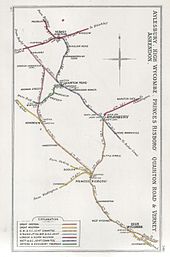- Metropolitan and Great Central Joint Railway
-
The Metropolitan and Great Central Joint Railway was a railway line extending from Harrow on the Hill in what is now north-western Greater London to Verney Junction in Buckinghamshire, England.
History
 A 1911 Railway Clearing House Junction Diagram showing the northern end of the MGCJR (blue/pink)
A 1911 Railway Clearing House Junction Diagram showing the northern end of the MGCJR (blue/pink)
 A 1914 Railway Clearing House Junction Diagram showing the southern end of the MGCJR (blue/pink)
A 1914 Railway Clearing House Junction Diagram showing the southern end of the MGCJR (blue/pink)
On 2 April 1906, the same day that the Great Western and Great Central Joint Railway (GWGCJR) was opened, the Metropolitan and Great Central Joint Railway (MGCJR) was created.[1] This took over the lines of the Metropolitan Railway (MR) north and west of Harrow South Junction, with the exception of the branch to Uxbridge. These comprised the main line between Harrow-on-the-Hill and Verney Junction and the branches from Chalfont & Latimer to Chesham and from Quainton Road to Brill.[2] The MGCJR was created under the terms of the Metropolitan & Great Central Railway Act, which received Royal Assent on 4 August 1905.[3]
Management of the joint line was to be in alternate periods of five years by the two co-owners, the first five-year term being that of the MR.[3]
After establishment of the MGCJR, new stations were opened at Sandy Lodge in 1910, and at North Harrow in 1915.[4]
Aylesbury station was leased jointly to the MGCJR and the GWGCJR from 1907.[4]
The branch to Watford from Rickmansworth was authorised under an Act of Parliament obtained by the MR on 7 August 1912, but was a MGCJR project. Purchase of land began in 1914, but the First World War held up further progress, and the first contract for construction was not placed until December 1922.[3]
At the start of 1923, the GCR was a constituent of the newly-created London and North Eastern Railway; and on 1 July 1933, the MR was a constituent of the London Passenger Transport Board. Through both these changes of ownership, the MGCJR retained its title, and was listed in the Transport Act 1947 as one of the "bodies whose undertakings are transferred to the [British Transport] Commission".[5]
Notes
References
- Dow, George (1965). Great Central, Volume Three: Fay Sets the Pace, 1900-1922. Shepperton: Ian Allan. ISBN 0 7110 0263 0.
- His Majesty's Government (6 August 1947). "Transport Act 1947 (10 & 11 Geo. 6 ch. 49)" (PDF). London: His Majesty's Stationery Office. http://www.railwaysarchive.co.uk/documents/HMG_Act1947.pdf. Retrieved 5 August 2011.

This England rail transport related article is a stub. You can help Wikipedia by expanding it.
